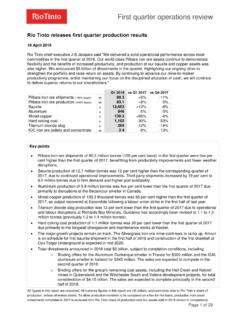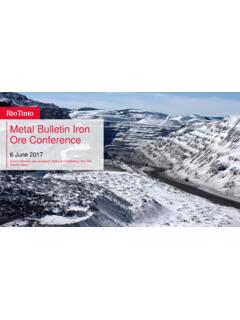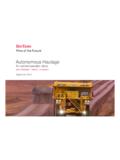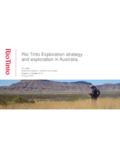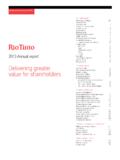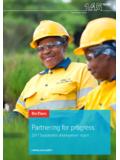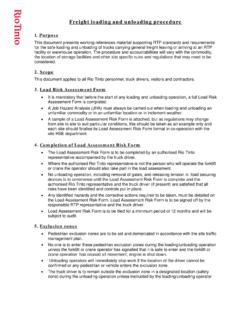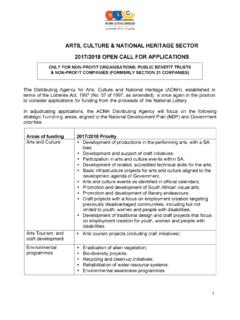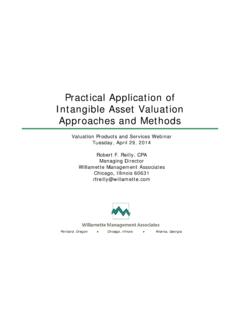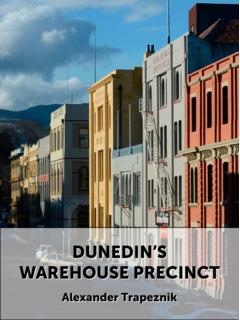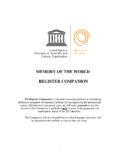Transcription of Why cultural heritage matters - Rio Tinto Group
1 Why cultural heritage mattersA resource guide for integratingcultural heritage management into Communities work at Rio TintoAbout Rio TintoRio Tinto is a leading global business involved in each stage of metal and mineral production. We produce aluminium, copper, diamonds, coal, iron ore, uranium, gold and industrial minerals. We operate in more than 50 countries and employ about 77,000 people, and many more work on our sites in contract roles. Health and safety is a key priority for us and we seek to place sustainable development at the heart of everything we do. We are a global organisation with one set of standards and values, while paying particular attention to the unique needs and aspirations of the communities that host our Tseveen Ayush competing in traditional archery at the 2010 National Naadam Festival, Mongolia.
2 Mr Tseveen is the most respected traditional archer in Mongolia and has been recognised by the Mongolian Government as a Distinguished Athlete. Oyu Tolgoi supports the National Naadam Festival which features traditional archery, wrestling and horseracing. The National Naadam Festival has been added to the UNESCO Intangible cultural heritage List. Why cultural heritage mattersA resource guide for integrating cultural heritage management into Communities work at Rio TintoContents1. IntroductionForewords About this guide 10 Contributors to this guide 12 Key concepts 14 Introduction 2. How to Inclusive engagement Know and understand Plan and implement Monitor, evaluate and improve Report and communicate Summary 883.
3 Background cultural heritage concepts The business case 10 Impacts on cultural heritage International protocols and standards for protecting cultural heritage and diversity 1094. ReferencesAcronym list 118 Glossary 119 Rio Tinto s policies, standards and guidances 124 Key websites 125 References 126 LeftDancers from the /Abi //Aeb cultural Group perform at the Rossing 30 Year Celebration in 2006. The Group s name means rain-time and their dance style is traditional to this region of Namibia, Tinto in Weipa, AustraliaInclusive engagement at Rio Tinto Alcan Weipa 26 Rio Tinto in Jadar, SerbiaInvolving experts in early desktop review for identifying cultural heritage 34 Rio Tinto in Phalaborwa, South AfricaAddressing legal requirements while furthering cultural heritage goals 38 Rio Tinto in Quebec, CanadaRecognising the heritage value of Canada s aluminium industry 40 Rio Tinto in Zvishavane, Zimbabwe Planning relocation of signifi cant heritage and honouring cultural needs 52 Rio Tinto Aboriginal Fund, Australia Supporting culture beyond our operations 58 Rio Tinto in Richards Bay.
4 South Africa Mananga heritage Centre: a living memorial 60 Rio Tinto in the Upper Hunter Valley, Australia Implementing an integrative cultural heritage Management System 64 Rio Tinto in the Northwest Territories, Canada Incorporating traditional knowledge into scientifi c monitoring at Diavik Diamond Mine 68 Rio Tinto in Oyu Tolgoi, Mongolia Design and monitoring framework: standards of acceptable change 74 Rio Tinto in the Pilbara, Australia Continual improvement of heritage performance 78 Rio Tinto in Utah, USPromoting industrial heritage values of an operating mine 84 Rio Tinto in the East Kimberley, Australia Open and transparent communication at Argyle Diamonds 8621346781011121395 Case studiesIntroduction08 Sam WalshChief executive, Iron Ore and AustraliaForewordsRespect for culture and heritage is integral to the way Rio Tinto conducts business.
5 Wherever we operate, our businesses work with local and Indigenous communities on the protection of their cultural heritage . We do this because it is the right thing to do and because there is a strong business case for doing recognise that protecting culture and heritage is important to communities and, therefore, it is important to us. This is why we engage so thoroughly with our host communities to build strong relationships, understand cultural heritage values and manage the local and regional impacts of our operations. Introduction09 What I have particularly noticed with this work is its breadth and complexity, as well as the considerable internal effort that it takes to get it right. We dedicate highly skilled people and invest substantial fi nancial resources in cultural heritage management.
6 We are also clear about the need to fully integrate this work across all parts of our businesses to achieve the best the case studies in this guide demonstrate, there can be signifi cant cultural heritage threats and opportunities in the diverse areas in which we operate. This is often a complex and challenging environment, for which the experience and stories from others can certainly be most am sure that you will each have your own stories about community engagement. Each will have as a backdrop the overall commitment of your business and your operation to culture and heritage protection, as well as to the related capabilities and systems. A common and practical guide that refl ects our cultural heritage management approach is most important.
7 Even more so that it has been developed over many years of robust engagement with communities the world over. It is a guide for all Rio Tinto operations, including those activities associated with exploration, with integrated mining and with smelting and other processing. I commend this guide as a resource for not only the Communities staff of Rio Tinto , but also for all employees involved in project development and land management work indeed, to those more broadly in our businesses. It is a practical toolkit that will help you to better understand cultural heritage considerations and incorporate them into your planning and programming. I would like to think that this guide will enrich your understanding and in turn lead to more effective collaboration with our host communities, particularly to protect and perpetuate their cultural HarveyGlobal practice leader, Communities and social performance ForewordsAt Rio Tinto we recognise the fundamental role that culture and heritage plays in our engagement with local communities.
8 We know that culture is the basis of all social identity and development, and cultural heritage is the endowment that each generation receives and passes on. We understand that protecting and managing cultural heritage assets jointly with communities contributes to the quality of our relationships. Greater attention to cultural heritage helps us be more effective in our community engagement and enhances our legacy. Introduction011We want to increase the level of trust our host communities have in us. We can build trust through the protection and celebration of cultural heritage and going beyond compliance with cultural heritage provisions in the UN Declaration on Human Rights. Celebrating the distinct cultural achievements and heritage of our host communities provides a foundation of confi dence and trust.
9 This foundation enables us to work in partnership with our host communities to ensure they benefi t from the sustainable economic opportunities provided by our activities. This is the essence of Rio Tinto s sustainable development recent times we have made signifi cant advances in community engagement practices. We are building a solid architecture of polices, standards and systems that facilitate engagement and sustainable economic and social outcomes for host communities. Recognition of our host communities culture and heritage is explicit in our Communities policy and standard, which clearly state our businesses responsibility to protect and help maintain cultural complexity and variability of cultural heritage in the many places that we operate has highlighted the need for additional guidance to complement our existing tools and guidelines on cultural heritage management.
10 cultural heritage considerations cut across all stages of an operation s lifecycle, from exploration through to closure, and many operational dimensions, such as community relations, environment and land management, mine planning and human resources. This guide outlines cultural heritage management considerations through all of these stages and Rio Tinto we place great importance on our relationships with host communities but we know that we do not always achieve the outcomes that we and others want. Some of our businesses have engaged with host communities to achieve very positive cultural heritage outcomes but others have further progress to make. Some achievements are highlighted in the case studies in this guide and we plan to build on Tinto is committed to respecting human rights, including the potential impacts of our activities on cultural identity and heritage .
